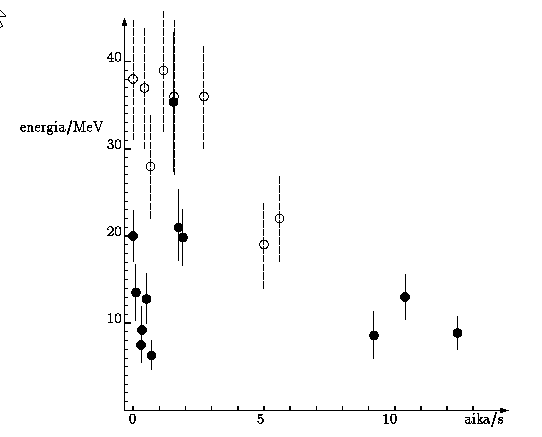Supernova neutrinos

Neutrinos produced in a stellar collapse
During the collapse of a star, about 1057 neutrinos are produced.The observations of SN1987A
Progenitor: Sandulaek -890 202 at Large Magellanic Cloud. Mass 15-18 solar masses.
Optical observation 24 February 1987.
Neutrino observations at February 23 7:35 UTC:

The dashed lines are observations of IMB
[ref]
and the continuos lines are of Kamiokande.
[ref]
The horizontal axis is time in seconds and the vertical axis is
energy in MeV.
NEW: Observations of IMB
Photos displaying the computer output of the events recorded by the IMB detector (23 February 1987):
| 33162 | 33164 | 33167 | 33168 | 33170 | 33173 | 33179 | 33184, |
The viewer's eye has been placed at the origin of what is probably an (anti)neutrino interaction on a proton giving a positron and a neutron. The neutron goes undetected but a positron produces a cone of Cherenkiv light in the water which is detected by some of the 2048 photomultiplier tubes (PMT's) arrayed on the six walls of the detector. Each wall is divided into rectangular patches outlined by a given color (red, blue, yellow). The small dashes and crosses represent outputs of individual PMT's. The number of lines is proportional to the light that hit the PMT and the color repserents the time of the hits. The time-color scale (in nanoseconds) is shown on the left.
The cones of Cherenkov light don't produce exact circles of PMT hits due to scattering and showering of the positrons in water. The best circle is event 33167. Event 33170 shows a Cherenkov cone grazing the blue and orange walls and then hitting the red wall head-on about 60 ns later.
The eight events came within a time itnerval of about 5 seconds, whereas the normal rate of such low energy events originating on the interior of the detector was about one every week. Hence the odds against these events being a statistical fluke are truly astronomical.
Properties of the supernova
One can make the following estimations from the neutrino and photon observations of SN1987A
- energy emitted in antineutrinos (3-6) 10 45 J
- energy emitted in all neutrinos (2 ± 1) 10 46 J
- kinetic energy (1.4 ± 0.1) 10 44 J
- the duration of the neutrino pulse 13 seconds
Implications of the observations of SN1987A for neutrino propeties
To be added.Future supernovae
Existing or planned detectors capable of detecting neutrinos from supernovae:| Experiment | location | type | direction? | spectrum? | threshold energy | Expected events | Starting year |
|---|---|---|---|---|---|---|---|
| Homestake | U.S.A. | radiochemical | no | no | 0.8 MeV | 6 | 1970 |
| SAGE | Baksan | radiochemical | no | no | 0.233 MeV | 1 | 1990 |
| Gallex | Gran Sasso | radiochemical | no | no | 0.233 MeV | 1 | 1990-1997 |
| GNO | Gran Sasso | radiochemical | no | no | 0.233 MeV | 1 | 1998- |
| SuperKamiokande | Japan | water Cerenkov | yes | yes | 5 MeV | 4000 | 1996- |
| SNO | Canada | Cerenkov + | yes | yes | 5 MeV | 800 | 1999 |
| Borexino | Gran Sasso | liquid scintillator | no | yes | 0.25 MeV | 20 | 2000 |
| LVD | Gran Sasso | liquid scintillator | no | yes | 5- 7 MeV | 300-700 | 1991 |
| Macro | Gran Sasso | liquid scintillator streamer tube |
no | yes | 7 MeV | 150 | 1989 |
| ICARUS | Gran Sasso | liquid argon | 5 | 10 | 1999? | ||
| Amanda | South Pole | ice Cerenkov | at GeVs | at GeVs | 0.5 MeV | 20 000 | 1995 |
| Baksan | Caucasus | liquid scintillator | 8 MeV | 50 | 1980 | ||
| LSND | Los Alamos | liquid scintillator | 5 MeV | 70 | |||
| Iodine | Homestake | radiochemical | 0.664 MeV | 25 | 200? |
Direction and spectrum refer to the ability of the detector to estimate (even statistically) the direction and energy spectrum of the neutrino burst. Expected events counts the number of events for a galactic supernova, inside 10 kpc. This is only an order of magnitude estimate. The efficiency of the detector may vary during the planning, the construction and the run.
Other supernova pages in the web
Supernova pages by Marcos Montes: a huge list of links.SuperNova Early Warning System (SNEWS)
International Supernovae Network - amateur and professional supernova hunters
Sungweb: SUpernova Neutrino Generation tool by Jorge Zuluaga
Back to mainpage